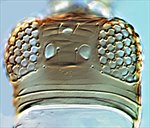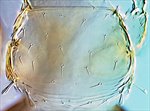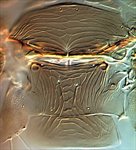Generic diagnosis
Female macropterous. Head wider than long, mouth cone long; maxillary palps 3-segmented; eyes with five weakly pigmented facets; ocellar setae I present, setae III short; four pairs of minute postocular setae. Antennae 8-segmented; segment I without paired dorso-apical setae; III and IV with forked, long and curved sense-cones; V–VI with a few microtrichia on both surfaces. Pronotum with two pairs of stout, broadly expanded, posteroangular setae; four pairs of posteromarginal setae. Mesonotum anterior campaniform sensilla present; median setal pair close to posterior margin. Metanotum irregularly reticulate; median pair of setae situated far from anterior margin; campaniform sensilla present near posterior margin. Fore wing narrow; first vein with setal row sparse on distal half; second vein with five to six widely spaced setae; clavus with five veinal and one discal setae; posteromarginal fringe cilia straight. Prosternal ferna weakly connected medially; basantra membranous, without setae; prospinasternum broad and transverse; endofurca with spinula weakly developed. Mesosternum with sternopleural sutures reaching anterior margin. Metasternum posterior margin with pair of thorn-like setae medially, and broad fringe between these setae; endofurca without spinula. Tarsi 2-segmented. Tergites without ctenidia; II–VIII each with broad continuous craspedum, median campaniform sensilla close to posterior margin; VIII without comb; IX with two pairs of campaniform sensilla; X with median split almost complete. Sternites without discal stae; III–VII with three pairs of posteromarginal setae, II with two pairs, posteromarginal setae displaced onto craspeda but median pair on VII in front of margin; II–VI with broad craspeda, lobed on VII; laterotergites without discal setae, with broad posteromarginal fringe.
Male similar to female; sternites III–VII each with small circular pore plate close to antecostal ridge.
Biological data
Members of this genus are usually found on the leaves of Fabaceae, including the widely planted coverr crop, Kudzu (Pueraria montana).
Distribution data
This genus is probably native to southeast Asia, although minimus Hood is well established in the Caribbean region (Mound & Marullo, 1986). The species collected in the southern tropical area of China was described from Japan (Kudo, 1972).
Nomenclatural data
Salpingothrips Hood, 1935: 157. Type species Salpingothrips minimus Hood, 1935, by monotypy.
Three species are known in this genus (ThripsWiki, 2020) of which one is recorded from China:
aimotofus Kudo, 1972: 230.
Relationship data
Thripidae sub-family Thripinae: this is a diverse group involving more than 230 genera. The relationships of this genus are far from clear. and the following combination of character states is remarkable: presence of ocellar setae pair I, presence of craspeda on tergites and sternites, lack of a spinula on the thoracic furcae, and the uniquely capitate pronotal posteroangular setae.
References
Kudo I (1972) A new species of the genus Salpingothrips from Japan. Kontyu 40: 230–233.
Mound LA & Marullo R (1996) The Thrips of Central and South America: An Introduction. Memoirs on Entomology, International 6: 1–488.
ThripsWiki (2020). ThripsWiki - providing information on the World's thrips. <http://thrips.info/wiki/Main_Page>



